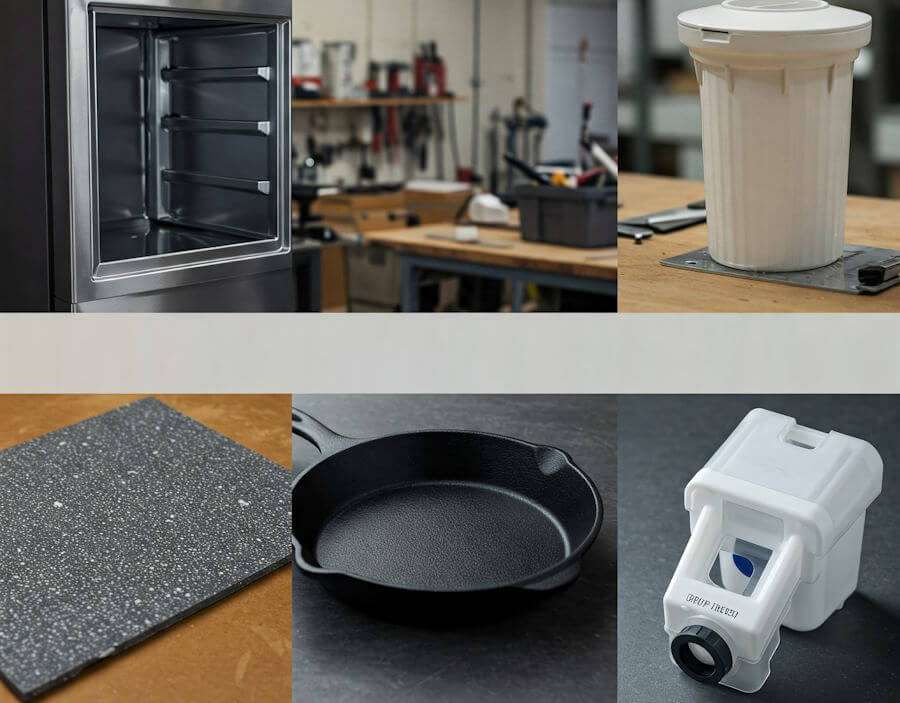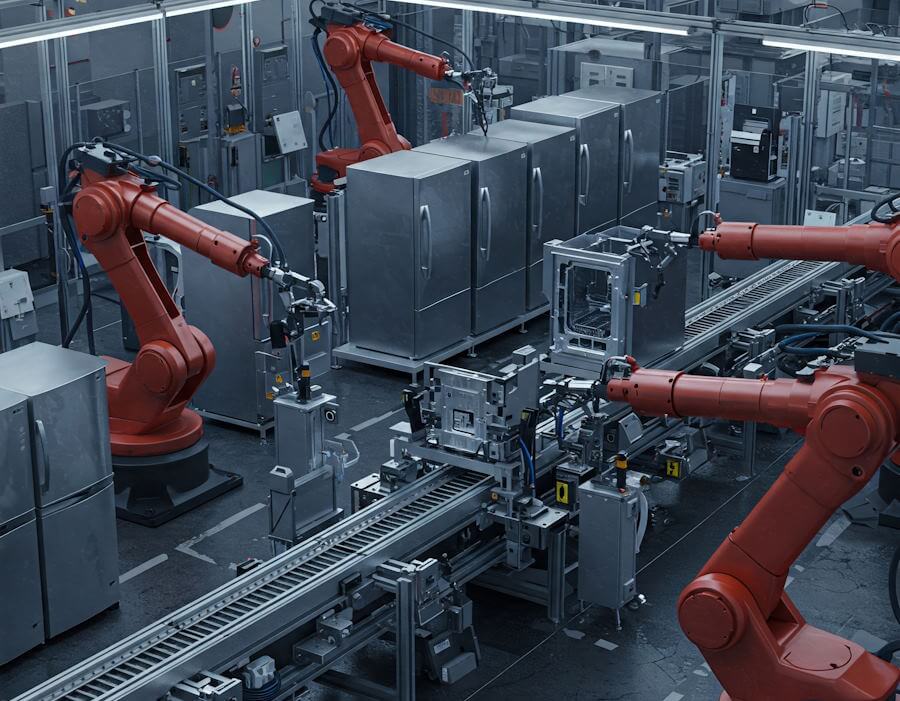Durability in home appliances plays a pivotal role in ensuring functionality, longevity, and customer satisfaction. When consumers invest in appliances, the anticipated lifespan directly impacts their purchasing decisions. Quality materials contribute significantly to the durability of home appliances, making material selection a critical factor for both manufacturers and consumers alike.
The lifespan of an appliance often hinges on the materials used in its construction. High-quality materials can resist wear and tear, reducing the frequency of repairs and replacements. Conversely, cheaper alternatives may initially reduce costs but often lead to increased long-term expenses due to the need for repairs or premature replacements. Investing in durable products translates to greater reliability, which can ultimately save consumers money over time. Appliances made from robust materials tend to require fewer part replacements and service calls, resulting in overall reduced maintenance costs.
Moreover, the choice of materials extends beyond mere cost-effectiveness. Environmentally conscious consumers are increasingly aware of the ecological implications associated with appliance durability. Appliances built with sustainable, high-quality materials contribute to a reduction in waste, as they are less likely to end up in landfills due to early disposal. Selecting durable home appliances can help consumers minimize their environmental footprint while enjoying the benefits of reliable performance.
In summary, the durability of home appliances is a crucial consideration driven by material choices. Opting for appliances constructed from high-quality, resilient materials can significantly enhance their lifespan, ultimately providing financial and environmental advantages. As consumers become more discerning, understanding the importance of appliance durability and material selection will empower them to make informed purchasing decisions.
Metals: The Backbone of Durability
When it comes to constructing durable home appliances, metals are often viewed as the backbone of robustness and longevity. Among the various types of metals, stainless steel, aluminum, and iron frequently emerge as the primary choices for manufacturers due to their unique properties and benefits.
Stainless steel is renowned for its exceptional strength and resistance to corrosion. This metal is an alloy primarily composed of iron, carbon, and chromium, which imparts superior durability and a sleek aesthetic. The resistance to rust and staining makes stainless steel an ideal choice for appliances exposed to moisture, such as refrigerators and dishwashers. Additionally, it is relatively easy to clean and maintain, contributing further to its applicability in the household context.
On the other hand, aluminum stands out for its lightweight nature and excellent conductivity. This metal is often used in manufacturing components requiring high strength-to-weight ratios, such as in the frames of light appliances or the casing of microwaves. The affordability and versatility of aluminum make it a popular choice among appliance manufacturers. Moreover, its resistance to rust enhances its appeal in environments where moisture might be a concern.
Iron, particularly cast iron, is another material commonly utilized in the production of home appliances. Known for its exceptional heat retention and durability, cast iron is frequently employed in cookware and heating appliances. While it may be heavier than other metals, its capability to withstand high temperatures makes it a preferred option for stoves and griddles. When properly maintained, iron can last for decades, offering a sustainable solution in appliance design.
In summary, the choice of metal significantly influences the durability and functionality of home appliances. With materials like stainless steel, aluminum, and iron at the forefront, manufacturers can ensure they are producing high-quality products that stand the test of time.
Plastics: Versatile and Lightweight Options
Plastics have become a cornerstone of modern appliance manufacturing due to their unique combination of lightweight characteristics and versatility. Among the various types of plastics, acrylonitrile butadiene styrene (ABS) and polycarbonate are widely used in the production of durable home appliances. These materials not only meet the practical requirements for strength and durability but also help reduce the overall weight of appliances, which can enhance usability and efficiency.
ABS is revered for its outstanding impact resistance and structural integrity, making it an ideal choice for components that may experience rough handling or require durability over time. It is commonly used in the casings of kitchen appliances, such as mixers and blenders, where durability is essential. Similarly, polycarbonate offers impressive heat resistance and transparency, which is beneficial for parts that require visibility, such as appliance covers and containers. Its strong yet lightweight nature helps to create products that are not only functional but also aesthetically pleasing.
Furthermore, the use of plastics in manufacturing appliances contributes to energy efficiency. The lighter weight of plastic components often leads to lower energy consumption during the manufacturing process as well as in the appliances’ daily operations. In addition, plastics can be engineered to provide excellent insulation properties, which is particularly useful in energy-efficient refrigerators and ovens.
Moreover, advancements in plastic technology continue to introduce new formulations that enhance the strength, chemical resistance, and longevity of these materials. Manufacturers are increasingly adopting such innovations to meet consumer demand for high-quality, long-lasting home appliances. The integration of durable plastics is undeniably transforming the landscape of appliance design, ensuring that modern products remain competitive, efficient, and user-friendly.
Glass: Aesthetic and Functional Features
In the realm of home appliances, glass stands out as a remarkable material that seamlessly merges aesthetic appeal with functionality. Its transparent quality often elevates the visual elegance of appliances, making it a popular choice for designers who aim to create a sophisticated atmosphere in kitchens and living spaces. During contemporary design efforts, the use of glass is increasingly becoming prominent, reflecting a trend toward modernity.
Not all glass is created equal when it comes to durability and safety, particularly in high-stress kitchen environments. Tempered glass is one of the most common types utilized in home appliances. This type is manufactured through a process of extreme heating and rapid cooling, making it significantly stronger than regular glass. As a result, tempered glass is highly resistant to impacts and temperature fluctuations, reducing the risk of shattering. Its robust nature makes it an ideal choice for oven doors and cooktops, where both heat resistance and safety are paramount.
Laminated glass, another variant, consists of two or more layers of glass with an interlayer of polymer sandwiched in between. This configuration not only enhances the glass’s strength but also provides added protection, as it holds together even if shattered, minimizing the risk of injury. Laminated glass is often selected for refrigerator doors and other appliances that prioritize safety while retaining an elegant appearance.
Moreover, the use of glass in home appliances allows for easy maintenance and cleaning. The smooth surface is less prone to retaining stains, making it simpler for homeowners to maintain a tidy environment. In summary, glass serves as a perfect blend of durability and allure, ensuring that home appliances are not only functional but also visually appealing. Its various forms, such as tempered and laminated glass, significantly contribute to the safety and longevity of essential household items, thereby reinforcing its value in modern design.
Composites: Combining Strength and Weight Savings
Composite materials have gained significant traction in the design and manufacturing of durable home appliances, offering a range of benefits due to their unique properties. These materials, primarily composed of two or more constituent elements, provide a combination of strength and weight savings that traditional materials often cannot achieve. Among the most prominent examples of composites are fiberglass and carbon fiber, each possessing distinct attributes that make them suitable for various applications in household appliances.
Fiberglass, a composite made from glass fibers embedded in a resin matrix, is well-known for its lightweight nature and robust mechanical properties. Its resistance to corrosion and thermal insulation capabilities make it an ideal choice for appliances like washing machines and refrigerators, where durability and energy efficiency are crucial. The lightweight characteristic of fiberglass not only makes transportation easier but also contributes to energy savings during appliance operation.
On the other hand, carbon fiber, renowned for its superior strength-to-weight ratio, is increasingly finding its way into high-end home appliances. Carbon fiber-reinforced composites exhibit remarkable rigidity and performance, often utilized in the construction of components subjected to high stress or frequent use. For example, high-performance kitchen appliances can benefit from carbon fiber housings that are both aesthetically appealing and extraordinarily strong, thus enhancing longevity while minimizing overall weight.
The advantages of using composite materials extend beyond mere physical properties. By integrating composites into appliance design, manufacturers can reduce material costs and production time, leading to a more efficient manufacturing process. Furthermore, the versatility of composites allows for innovative designs that can enhance user experience through improved usability and aesthetics. As the demand for durable and energy-efficient home appliances continues to grow, composite materials will undoubtedly play a pivotal role in shaping the future of appliance design.
Innovative Materials and Emerging Technologies
The ongoing advancements in materials science have led to the development of innovative materials that promise to significantly enhance the durability of home appliances. One notable area of research is nanotechnology, which involves manipulating materials at the molecular or atomic level. This technology enables the creation of stronger, lighter, and more resilient products. For instance, incorporating nanomaterials into coatings can enhance scratch resistance and improve longevity, elevating the performance of common household appliances.
Alongside nanotechnology, the evolution of smart materials is another promising avenue for increasing durability. Smart materials can respond dynamically to environmental changes. This adaptability allows appliances to maintain optimal operational integrity under varied conditions, ultimately extending their lifespan. For example, temperature-sensitive materials can be utilized in ovens or refrigerators to optimize energy consumption while ensuring consistent performance, effectively mitigating wear over time.
Furthermore, self-healing polymers represent a revolutionary step in materials development. These advanced materials possess inherent capabilities to repair themselves after suffering damage. The incorporation of self-healing properties can address common durability issues such as cracks or frays in appliance casings. By integrating these polymers into everyday household appliances, manufacturers can drastically reduce the frequency of repairs and replacements, prompting a shift towards sustainability in production practices.
As research continues to uncover the potential applications of these innovative materials, the prospects for creating more durable home appliances become increasingly optimistic. By utilizing nanotechnology, smart materials, and self-healing polymers, the manufacturing industry is poised to address durability challenges effectively. It is essential for future developments to focus not only on performance but also on the sustainable use of resources to assure long-term benefits for consumers and the environment alike.
Environmental Considerations in Material Selection
When it comes to the manufacturing of durable home appliances, choosing environmentally friendly materials plays a critical role. Today, consumers are increasingly aware of the environmental impact of their purchases, which has led to a growing demand for products made from sustainable materials. This trend emphasizes the importance of incorporating sustainability practices in the material selection process, which not only meets consumer expectations but also promotes ecological balance.
Environmental considerations encompass various aspects, including the sourcing of raw materials, their life cycle, and the potential for recycling at the end of their usability. Manufacturers are now focusing on using renewable resources, such as bamboo or recycled metals, as primary materials. These sustainable options help to reduce the carbon footprint associated with the extraction and processing of virgin materials, showcasing a commitment to environmental stewardship. Furthermore, products created with recycled materials often require less energy during production, which further diminishes their environmental impact.
In addition to being sustainable, the choice of eco-friendly materials can significantly influence the durability of appliances. For instance, some biodegradable or recyclable materials, when utilized properly, can enhance the longevity of a product, thereby reducing waste. This aligns with a circular economy approach, where materials are consistently reused, thus minimizing waste and resource depletion. Additionally, manufacturers that prioritize environmentally friendly materials often find themselves appealing to a market segment that increasingly values durability, sustainability, and ethical production practices.
Overall, the decision to select environmentally friendly materials has profound implications on consumer demand and longevity of home appliances. By investing in sustainable practices, manufacturers not only contribute positively to the planet but also build a loyal customer base that appreciates eco-conscious options.
Cost vs. Durability: A Balancing Act
When considering the materials for building home appliances, a critical evaluation of cost versus durability plays a vital role. Consumers often encounter the dilemma of whether to invest in high-quality, durable materials or to opt for more affordable options that may not provide the same lifespan or efficiency. Durable materials, such as stainless steel or high-grade plastics, typically come with a higher initial price tag. However, these investments can yield substantial long-term savings.
Initially, one might be tempted to select cheaper materials to keep upfront costs low. Yet, this approach may lead to increased expenses over time due to frequent repairs, replacements, and maintenance. For instance, appliances made from lower-quality materials may become prone to wear and tear, ultimately leading to a higher frequency of repairs or even the need for a complete replacement sooner than expected. In contrast, investing in durable materials can decrease maintenance costs and extend the overall lifespan of the appliance, providing a more economical solution in the long run.
Moreover, durable materials often enhance the efficiency of home appliances. For example, appliances with higher durability ratings typically require less energy to operate, contributing to reduced utility bills. By choosing high-quality materials, consumers not only secure their investment but also benefit from lower operating costs over time.
Additionally, it is essential to consider the environmental impact of choosing durable materials. Opting for long-lasting options can significantly reduce waste and resource consumption, aligning with sustainable practices. Thus, while the initial expense may seem daunting, the long-term financial benefits, alongside environmental considerations, demonstrate that investing in durable materials is a strategic decision for both consumers and the planet.
Conclusion: Making Informed Choices
In the realm of home appliances, the selection of materials used in their construction is paramount in determining their durability, functionality, and overall value. Throughout this discussion, we explored the unique properties of various materials, including stainless steel, plastic, and glass, each offering distinct advantages and disadvantages. Understanding these attributes empowers consumers to make informed choices when it comes to investing in home appliances.
For instance, stainless steel is often lauded for its strength and long-lasting nature, making it a popular choice for kitchen appliances. Conversely, while plastic tends to be lightweight and cost-effective, it may not always withstand the rigors of daily use as effectively as metals. Glass, on the other hand, provides an aesthetic appeal but can be susceptible to breakage, thus necessitating careful handling. Each material possesses specific characteristics that can significantly affect an appliance’s life span and performance.
As consumers navigate their options, it is essential to weigh not only the immediate costs but also the long-term durability that different materials offer. By prioritizing durability, individuals can ensure that their selections will withstand the test of time, leading to better value and less frequent replacements. Furthermore, understanding the pros and cons of each material empowers consumers to select appliances that best fit their lifestyle and needs.
In conclusion, considering the material composition as a crucial factor when purchasing home appliances is vital for making sound investments. By being informed about the various materials available and their respective benefits and limitations, consumers can significantly enhance their appliance choices, ensuring long-lasting satisfaction and utility in their living spaces.



